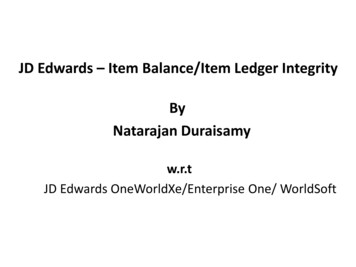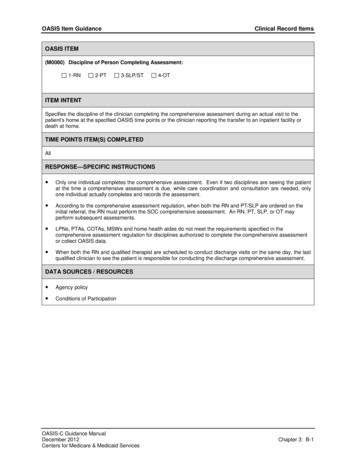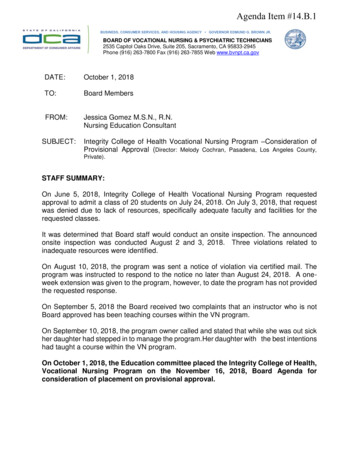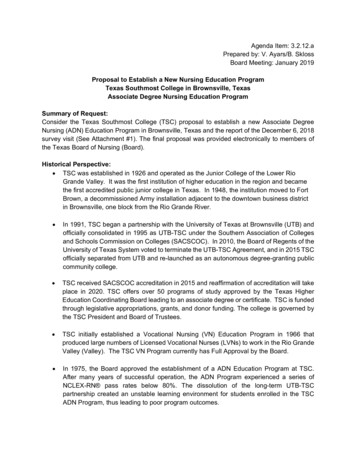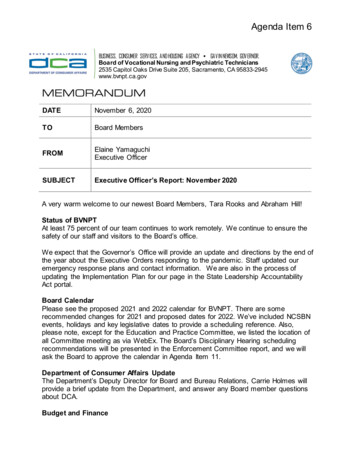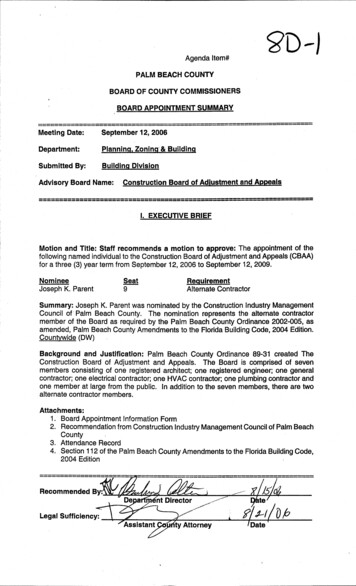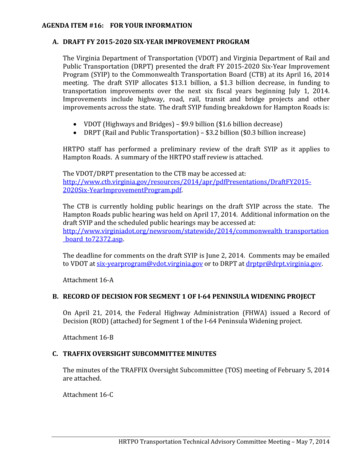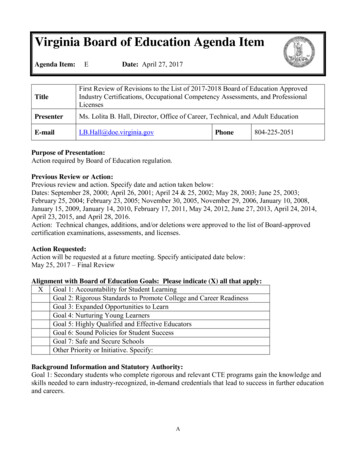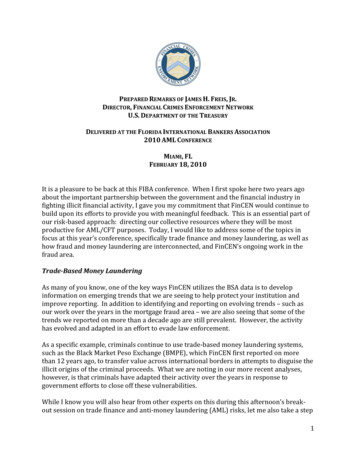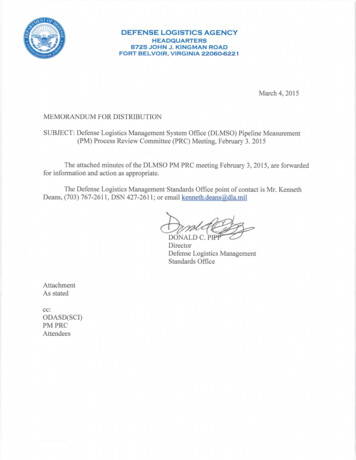
Transcription
March 4, 2015MEMORANDUM FOR RECORDSUBJECT: Defense Logistics Management Standards Office (DLMSO) Pipeline Measurement(PM) Process Review Committee (PRC) Meeting of February 3, 2015Agenda Item 1 — Opening RemarksAgenda Item 1A: Agenda CommentsMeeting Purpose: The Defense Logistics Management Standards Office (DLMSO) hostedthe subject meeting at DLA HQ, Fort Belvoir, Virginia. Defense Connect On Line (DCO)provided real-time access to presentation materials for those participants calling into the meeting.The focus of the meeting was to address open action items from the June, 2014 PM PRCmeeting, provide members with a high-level overview of pending Proposed DLMS Changes(PDCs), review the reports available from the Logistics Metrics Analysis Reporting System(LMARS), and present an overview of the Supply Chain Enterprise Metrics and comments fromthe Supply Chain Metrics Group (SCMG) support staff.The PM PRC Agenda (with hyperlinks to briefing materiels) and Attendee list are available onthe DLMSO website, at “Committees”, Pipeline Measurement (PM) PRC, archives Webpage:www.dla.mil/j-6/dlmso/Archives/archives pmprc.asp.Brief Summary of Discussion: Mr. Kenneth Deans, DLMSO PM PRC Chair, facilitated thediscussion. A summary of the agenda topics discussed appears below. Action items identifiedduring the meeting are to be worked within 30 days of this memorandum unless otherwise noted.Agenda Item 1B: Pipeline Measurement PRC Overview. Mr. Deans provided an overview ofthe PM PRC processes and LMARS functionality (click here to view Mr. Deans’ slides: PipelineMeasurement PRC Overview), targeted primarily to new members of the PRC. He reviewed theDoD policy and authority under which the PRC operates, pointing out the roles, authority, andadministrative procedures documented in DLM 4000.25 Volume 6, Chapter 4, noting the need torevise and update this chapter. (See Agenda Item 3F, below.)Participants discussed how the LMARS data is used by Services, agencies, and the SCMG. Mr.Dennis Zimmerman, LMI, contract support to the Office of the Deputy Assistant Secretary ofDefense (ODASD)/Supply Chain Integration (SCI), explained that the LMARS data itself is notbriefed at the SCMG meetings, but it provides the raw data used by SCI, Services, and agenciesto generate the metrics that they brief at the SCMG meetings. Mr. D. C. Pipp, Director, DLMSO,Page 1
requested confirmation that the LMARS data continues to be useful. Mr. Zimmerman replied itwas. Partly in response to a recent Government Accountability Office (GAO) audit of DoDDistribution that raised questions regarding the metrics generated by the Strategic DistributionDatabase (SDDB), Mr. Zimmerman said ODASD(SCI) is preparing a report to Congress thatwill document the Department’s progress in establishing supply chain metrics based on the fiveattributes of materiel readiness, responsiveness, reliability, cost, and planning and precision—henoted that LMARS data is the source for key enterprise metrics on responsiveness and reliability.Mr. Paul Blackwell, ODASD(SCI), added that while SCI does not dictate to the Services how tocalculate metrics that are important or meaningful to them, LMARS provides the same raw datato each. Ms. Heidi Daverede, DLMSO, concurred, adding that it is a major challenge to get all ofthe Services and agencies to use the same raw data as the basis for their individual metricscalculations and to consistently interpret the data across the enterprise, based on SCI policy.With reference to the LMARS-generated reports, Mr. Blackwell commented that even in caseswhere a Component may not use the LMARS reports; he thought LMARS should continue togenerate the reports, because they provide an “honest broker” functionality across the entireenterprise.Ms. Daverede noted that LMARS produces two distinct types of output: The raw LMARS datafile that is provided to all activities that request the file, and tailored usage reports by Service,agency, and shipment/service type. While we believe that most DoD supply-chain activities usethe raw LMARS data file, it is not clear that they use the LMARS-generated tailored reports. Mr.Blackwell concurred, adding that historically many activities did not have the capability tocollect and analyze their own data and as a result relied upon LMARS reporting. The Air Force’sLIMS-EV was cited as an example. Ms. Lisa Oakley concurred, stating that LIMS-EV does notuse requisitions from DLA’s Enterprise Business System (EBS), but instead uses maintenancerequests as its input. Mr. Zimmerman added that while LIMS-EV does produce logisticsresponse time (LRT) measurements, the Air Force is focused on customer wait time (CWT). Healso noted that SCI will cancel DoDI 4140.61 (CWT and time definite delivery (TDD)), andDoD 4140.64-M, the Secondary Item Stratification (STRAT) Manual; both will be replaced bythe updated DoDM 4140.01, Volume 10, a preliminary draft of which is currently under reviewby the community.Agenda Item 1C: Plan of Action and Milestones (PoAM). Mr. Deans reviewed the Plan ofAction and Milestones (PoAM) identifying milestones and enhancements to LMARS andpointing out milestones completed since the last PM PRC meeting.Agenda Item 2 — Address Open Action Items Mr. Deans provide a brief overview of theopen, closed, and new action items from the last PM PRC—only items 6, 7, and 9 remain open.With regard to action item 6, Mr. Pipp asked for details regarding “BR4”. Mr. Deans explainedBR4 is an Army-owned Routing Identifier Code (RIC) managed by DLA Distribution, RedRiver, Texarkana, TX.Agenda Item 3 — LMARS Proposed DLMS Changes (PDCs). Mr. Deans provided a briefoverview of several draft PDCs currently under development. The preliminary drafts of thePDCs are available via the following hyperlinks:Page 2
Agenda Item 3A: DRAFT PDC 1154 “DLA” LMARS Report Tab Transactions reportedunder this new tab will provide metrics when DLA in operating as a customer of anotherService/agency ICP.ACTION ITEM #1 Responsible Party: Kenneth Deans Status: OpenMr. Deans will continue to work with DLA Transaction Services and DLA to update and finalizethis draft PDC.Agenda Item 3B: DRAFT PDC 1038A Move DLMS 511R Image (Document IdentifierCode (DIC) CH ) Transactions from “Other” to Post Post Discussion ensued regarding theneed for, and fill rule methodologies to implement, this PDC. Mr. Deans noted that at the lastPM PRC, Mr. Zimmerman had pointed out the need to update the LMARS fill rules to bettercharacterize transactions that fall into the “other” category of the LMARS reports. The largestsingle group of transactions in the other category comprises Document Identifier Code (DIC)CH transactions, such as those generated by DLA at the Kentucky Logistics Operation Center(KYLOC) for distribution of clothing items to the Army. These are considered post-posttransactions, rather than immediate issue, and participants discussed the need to create a new filltype category for the LMARS reports to accommodate these types of transactions. Ms. Daveredesuggested a two-phased approach under which these transactions would be moved to immediateissue in the first phase, and then later, create a separate category and move the transaction intothat new category.ACTION ITEM #2 Responsible Party: Kenneth Deans Status: OpenMr. Deans will continue to resolve the issues related the LMARS fill rules for DIC CH andpost-post transactions. He will document the details in PDC 1038A.Agenda Item 3C: DRAFT PDC 1025D Navy Reserve Criteria per Previous ApprovedDLMS Change (ADC) Mr. Deans reported that there are approximately 65,000 Navy Reserveunits. In response to a previous request the Navy had not identified any DoDAACs as NavyReserve for use in the current LMARS reporting criteria. After further research and review, Navyconcurs with use of DoDAAD Major Command Code NO to identify Navy Reserve UnitDoDAACs.ACTION ITEM #3 Responsible Party: Kenneth Deans/Mary MaurerStatus: OpenMr. Deans and Ms. Mary Maurer, Rainbow Data/DLA Transaction Services, will continue towork with the Navy to update PDC 1052D with the appropriate values for Navy reserve units.Agenda Item 3D: DRAFT PDC 1025E To Add Routing Identifier code (RIC) AJ2 AsArmy ICP. The Army uses an inventory system, which is identified by RIC AJ2, to maintainthe availability balance file for all Army warehouses. When the Army receives DLA stockturned into an Army warehouse, instead of turning that materiel back into DLA for little or nocredit, they retain it in the Army Supply Support Activity warehouses. When an Armyrequisition is issued, AJ2 checks for stock availability in the Army warehouses first, and ifavailable, issues the item directly from the Army warehouse. Ms. Maurer stated that if AJ2 wereconsidered a wholesale ICP and received a requisition that could not be filled from an Armywarehouse, all the ICP Supply Processing Time (ISPT) would be charged to the new receivingPage 3
ICP; AJ2 would not receive any ISPT time. This PDC would include the processing time at AJ2in the ICP Processing Time segment of LMARS 1 .Agenda Item 3E: DRAFT PDC Cargo Routing Information File Process for LMARSMonthly Reports When a Navy ship is deployed, the ship-to address in the DoDAAC file maynot identify a reasonable location for cargo shipments to that ship; the CRIF better identifies thatlocation in real time. Navy already provides the CRIF data to DORRA for inclusion in SDDB;this PDC proposes that LMARS use the CRIF data to more accurately calculate LRT metrics forNavy ships when they are deployed.ACTION ITEM #4 Responsible Party: Kenneth Deans Status: OpenMr. Deans will continue to facilitate bi-weekly working sessions with key personnel from thesystems involved in the process to develop this PDC to include CRIF data in LMARS.Agenda Item 3F: DRAFT PDC Update LMARS DLM 4000.25 Vol. 6; Ch.4, PipelineMeasurement DLMSO staff is currently reviewing DLM 4000.25, Volume 6, Chapter 4 Pipeline Measurement, in preparation for submitting a PDC to revise it.ACTION ITEM #5 Responsible Party: All Component PRC RepsStatus: OpenMr. Deans requested that all PM PRC representatives review DLM 4000.25 Volume 6, Chapter 4so that they are prepared to review/approve the PDC when it is released for PRC staffing.Agenda Item 4 — LMARS Reports Mr. Deans provided a brief review of each of the LMARSreports (Guard; Reserve; Wholesale ICP; Wholesale ICP, Contractor; Wholesale ICP, CITBreakout; Wholesale ICP, Reparable NSNs; and ICP GSA), updating the data presented at thelast PRC in June with data from January 2015. The hyperlinks above link to the individual reportslides briefed during the PRC.Attendees raised several questions and provided comments about the reports: Why are the Air Force Reserve numbers so low?A: The numbers are generated based on DoDAACs provided to DLA Transaction Services byeach Component. If Air Force numbers are low, the air Force needs to verify the accuracy of theDoDAAC used by LMARS to generate the report.1Subsequent to the PRC meeting, DLA sent an e-mail to the chair stating that DLA does not consider AJ2a wholesale ICP, but an internal mechanism that enables an internal Army inventory check beforesending a requisition to the wholesale ICP. As such, the time taken to perform that check should countagainst the Service Processing segment, not the ICP Processing segment. DLA stated they would nonconcur with any PDC that would make AJ2 a wholesale ICP for that reason. (DLMSO MILSTRIPAdministrator clarified that the DLA position is correct if the requisition is ultimately forwarded to DLA.However, if the requisition is supported directly from AJ2 stock, AJ2 is acting as an ICP. Any PDCdocumentation must make this distinction for LMARS processing.)Page 4
ACTION ITEM #6 Responsible Party: Air Force PM PRC Rep Status: OpenThe Air Force PRC representative will verify that the DoDAACs LMARS uses to identify AirForce Reserve units 2 are accurate and complete.Also, reserve units are sometimes embedded with active units, and may use the active units’DoDAACs while embedded. Ms. Hilert noted some outdated notes on the report page (“DoD 4140.1-R”; “DEPRA”). Mr. Madrigal noted an outdated reference in the Processing Group column header.A: Mr. Deans explained that he had used old screen shots 3 of the reports as the background forthe slides, and the outdated references are in the process of being corrected in the current reports.ACTION ITEM #7 Responsible Party: Kenneth Deans Status: OpenMr. Deans will verify that the outdated references on the background slides have been updated inthe LMARS reports. Ms. Hilert noted that the definition4 of LRT on the “LMARS Reports” slide needed to beupdated. She commented that in many cases, the requisitioned materiel is never posted tothe materiel management system of the requisitioner. In that case LMARS uses the MRAdate as the end date for LRT.A: ACTION ITEM #8Responsible Party: Kenneth Deans Status: OpenMr. Deans said he would notify the Supply Chain Metrics Group (SCMG) staff of Ms. Hilert’sconcerns regarding the definition of LRT in the SCMG DNA charts, and ask them to update thedefinition. Mr. Zimmerman pointed out that total order-to-receipt time for a line on the LMARSreport is not the sum of the segment times on that line.Ms. Maurer explained that because LMARS data is a “snapshot in time” not all segmentsin the pipeline will close during the same reporting period. As a result, the sum of thesegment times for a particular line of the report may not equal the total order-to-receipttime.Agenda Item 5: Supply Chain Enterprise Metrics—SCMG CommentsMr. Zimmerman presented comments from the SCMG perspective on the data feed and reportsavailable from LMARS. He emphasized that his intent was not to “poke anyone in the eye”. 2When LMARS was established, the Components were not capable of collecting their ownmetrics data—generally, individual Components are capable of collecting and processingtheir own data today.Current DoDAACs assigned as Air Force Reserve in LMARS are DoDAACs Fx6600 through Fx6799.3Mr. Deans has updated these slides and posted revised versions to the DLMSO website; the updated slides usecurrent reports as background4This definition comes from the DNA charts used at the SCMG monthly meetings.Page 5
Partly as a result of that, activities across the enterprise do not collect the exact same data,(DLA, for example, collects Depot Level Reparable item data) and they do not processthe data they collect in the same way.Dollar valuations of materiel are not accurate.Agenda Item 5A: CORP-FILL-TYPE and IMD-CORP-FILLLMARS sorts data into the various reports differently based on fill rules. DLA has providedspecial fill rules to LMARS for sorting of DLA data. Reports based on these DLA special fillrules are referred to as “CORP-FILL” reports. LMARS also generates reports based on the“standard” fill rules, and provides reports based on those rules to all Components (includingDLA—DLA gets both sets of reports). Reports based on these standard fill rules are referred toas “IMD-CORP-FILL” reports. Both the CORP and the IMD fill rules are available on theLMARS link on the DLA Transaction Services mars/main.asp. Mr. Zimmerman contrasted some ofthe differences between the statistics in these two reports. (See Mr Zimmerman’s slides, here,CORP-FILL-TYPE and IMD-CORP-FILL for details.)Discussion ensued among the participants regarding who uses the CORP-FILL-TYPE reportdata. Ms. Maurer stated that only DLA uses the CORP-FILL data; Mr. Zimmerman said thatUSTRANSCOM’s SDDB also uses the CORP-FILL data. Fred Posten, USTRANSCOM, saidthat the SDDB now uses the IMD-CORP-FILL.Mr. Zimmerman also discussed the definition of “immediate issue”, noting that mean time forfulfillment of CONUS immediate issue requisitions is 16.8 days; OCONUS is 27.5 days. TheLMARS fill rule for immediate issue is based only on the ICP processing time; other pipelinesegments that may contribute significantly to the total processing time (TPT) for an immediateissue include depot processing time, in-transit time, and response take-up time.Mr. Zimmerman documented that in many cases a requisition for an item that is backorderedmay be fulfilled before an immediate issue, and an unplanned DVD item many take no longerthan for a planned DVD. The number of requisitions in the “other” category is high, and what isbeing measured in that category changes over time.Summarizing the issues with the current LMARS fill rules, Mr. Zimmerman suggested that weneed to improve the coding of how orders are filled. Mr. Blackwell proposed several steps tobreak down that process into phases: What is the problem? Who is the data for? What needs to change? Who will make the change(s)?Page 6
Agenda Item 5B: Low percentage of records with ICP processing timesMr. Zimmerman documented that a low percentage of the records in LMARS have an ICPprocessing time (ISPT). He presented these definitions for ISPT and Storage Activity ProcessingTime (SAPT):𝐼𝐼𝑆𝑆𝑃𝑃𝑇𝑇 𝐷𝐷𝑎𝑎𝑡𝑡𝑒𝑒 𝑜𝑜𝑓𝑓 ��𝑣𝑒𝑒 𝑠𝑠𝑢𝑢𝑝𝑝𝑝𝑝𝑙𝑙𝑦𝑦 𝑎𝑎𝑐𝑐𝑡𝑡𝑖𝑖𝑜𝑜𝑛𝑛 ��𝑖𝑡𝑡𝑖𝑖𝑜𝑜𝑛𝑛 ��𝑐𝑡𝑡𝑖𝑖𝑜𝑜𝑛𝑛 𝑑𝑑𝑎𝑎𝑡𝑡𝑒𝑒Date of positive supply action (STATUS DATE): First status DIC AERequisition transaction date (REQ-TRAN-DATE): Date of submitter’s message𝑆𝑆𝐴𝐴𝑃𝑃𝑇𝑇 � 𝑑𝑑𝑎𝑎𝑡𝑡𝑒𝑒 𝑀𝑀𝑅𝑅𝑂𝑂 𝑑𝑑𝑎𝑎𝑡𝑡𝑒𝑒Shipped date (SHIPPED DATE): Date released to carrier DIC AR /AS /AU RP 57-59MRO date (MAT-RLSE-ORDER-DATE): Date MRO received in DAASMs. Maurer said that the definition above for ISPT is incorrect; it is MRO date minus �𝑖𝑖𝑡𝑡𝑖𝑖𝑜𝑜𝑛𝑛 ��𝑐𝑡𝑡𝑖𝑖𝑜𝑜𝑛𝑛 𝑑𝑑𝑎𝑎𝑡𝑡𝑒𝑒. Since DVDs have no MRO date, LMARS creates one based onthe status BV or an AB transaction being received. ��𝑖𝑡𝑡𝑖𝑖𝑜𝑜𝑛𝑛 ��𝑐𝑡𝑡𝑖𝑖𝑜𝑜𝑛𝑛 𝑑𝑑𝑎𝑎𝑡𝑡𝑒𝑒 is the datethe transaction left DAAS, not the Date of submitter’s message.Discussion ensued regarding whether these definitions are documented in DLM 4000.25 Volume6; Chapter 4.ACTION ITEM #9 Responsible Party: Mary MaurerStatus: OpenMs. Maurer said she will verify whether these definitions are documented in DLM 4000.25Volume 6, Chapter 4.Mr. Zimmerman summarized the SCMG comments:ISPT – What can we do to capture ICP processing time more frequently? What data elements need to be collected to present an auditable trail for ICP processingtimes?SAPT – What can we do to capture depot processing time more frequently? Do we need a different time for orders going from an ICP to a planned DVD vendor? Do we need to differentiate between when a vendor can issue off-the-shelf and whenthere is a delay? Do we need a different time if an order is being delivered out of a camp, base, or stationand not out of a depot (i.e., a retail order)?Zero TPT – Is there a situation where a requisition can be generated, submitted to an ICP, released toa depot, shipped to a customer, and received into the customer’s system all in one day?Page 7
Pipeline Measurement Process Review CommitteeAgenda for Feb 3, 2015STARTING AT 8:30 AM ESTDLA Headquarters, 8725 John J Kingman Road, Room 1801, Fort Belvoir, VA 22060DCO: https://connect.dco.dod.mil/pm-prcCALL-IN NUMBER: 571-766-5141TOPIC#LEAD1Opening RemarksA. Agenda comments (Agenda from last meeting)B. Pipeline Measurement PRC OverviewC. Plan of Action and Milestones (PoAM)PM PRC ChairKen Deans2Address Closed, Open, New action items from last meetingKen Deans3LMARS Proposed DLMS ChangesA. DRAFT PDC 1154 “DLA” LMARS REPORT TABB. DRAFT PDC 1038A “Others” CH to Post PostC. DRAFT PDC 1025D Navy Reserve criteria per previous ADCD. DRAFT PDC 1025E to add RIC AJ2 as Army ICPE. DRAFT PDC Cargo Routing Information File process forLMARS monthly reportsF. DRAFT PDC update LMARS DoD 4000.25 Volume 6, Chapter 4,Pipeline MeasurementKen DeansMary Maurer4LMARS ReportsA. GuardB. ReserveC. WholesaleD. WholesaleE. WholesaleF. WholesaleG. ICP GSAKen DeansMary MaurerICPICP, ContractorICP CIT BreakoutICP Reparable NSNs5Supply Cha
Mar 04, 2015 · BR4 is an Army-owned Routing Identifier Code (RIC) managed by DLA Distribution, Red River, Texarkana, TX. . (KYLOC) for distribution of clothing items to the Army. These are considered post-post . Reserve for use in the current LMARS reporting

